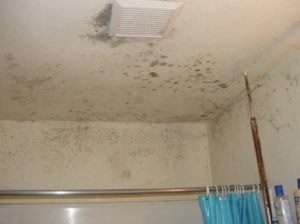Most of the mold found indoors comes from the outdoors because mold spores can easily float on gentle air currents. If the spores land on suitable organic material inside a building, mold can begin to grow. But mold needs two things in order to grow and survive: moisture and food.
Moisture
 Mold does not need a lot of moisture to grow. A little condensation in a bathroom or around a window sill, for example, can be enough. Common sites for indoor mold growth include bathroom tile and grout, basement walls, and areas around windows and sinks. Common sources of water or moisture include roof leaks, condensation due to high humidity or cold spots in a building, slow leaks at plumbing fixtures, humidification systems, sprinkler systems, and floods.
Mold does not need a lot of moisture to grow. A little condensation in a bathroom or around a window sill, for example, can be enough. Common sites for indoor mold growth include bathroom tile and grout, basement walls, and areas around windows and sinks. Common sources of water or moisture include roof leaks, condensation due to high humidity or cold spots in a building, slow leaks at plumbing fixtures, humidification systems, sprinkler systems, and floods.
Mold has been found to germinate, grow, and produce spores in as little as 24 hours after water damage occurs.
Indoor relative humidity (RH) should be between 20% and 40% in the winter, and less than 60% the rest of the year. Some experts recommended that indoor humidity levels, in general, should be between 40% and 60%.
Moisture is the most important factor influencing mold growth indoors. Controlling indoor moisture helps limit mold growth. Moisture control is the key to mold control.
Food
Besides moisture, mold needs nutrients, or food, to grow. Mold can grow on virtually any organic substance. Buildings are full of organic materials that mold can use as food, including paper, cloth, wood, plant material, and even soil. Molds secrete digestive enzymes that decompose the substrate, making nutrients available. Some molds can even digest synthetic materials, such as adhesives, pastes, and paints.
Molds can also grow on inorganic material, such as concrete, glass, and metal, because they can grow on the dirt or dust that is present on the surfaces of those materials.
In most cases, the temperature is not an issue; some molds grow in warm areas, while others prefer cool locations, such as bread stored in a refrigerator.
Mold grows well in environments between 40º to 100º F. (And the pH is usually between 3 and 8.) But some mold species have been found in hot springs with water temperatures above 120º F.
Often, more than one type of mold can be found growing in the same area, although conditions such as moisture, substrate, and temperature may favor one species of mold over another.
Conclusion
In conclusion, the following conditions are necessary for mold growth to thrive on surfaces: a temperature range between 40° and 100° F, the presence of mold spores, a nutrient base (most surfaces contain nutrients), and moisture. Mold growth is not desirable in a building and must be prevented. There are three reasons to prevent fungal growth inside a building: the potential negative health effects of exposure to fungi and their byproducts; the effects of mold contamination on the structural integrity of the building; and the negative aesthetic effects fungi can produce, both visually and on the human olfactory system.

